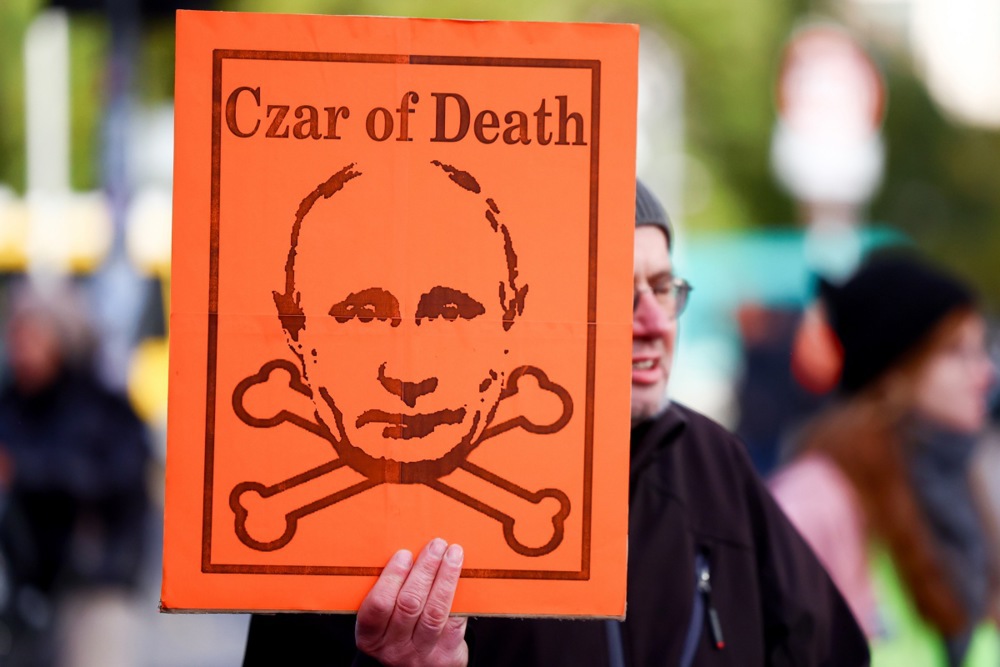There is no shortage of nuclear sabre-rattling in Russian propaganda. While the possibility of a nuclear confrontation between the superpowers is negligible, the psychological-informational war, of which nuclear threats are a part, is in full swing. The effects of this are also being felt in Slovenia.
More than two years after the start of Russia’s illegal aggression against Ukraine, hardly a day goes by without nuclear weapons being brandished in various forms. We hear threats from the Kremlin, and we often see animated depictions of the destruction of Western capitals in the Russian media. Intimidation also takes the form of changes to strategic documents and, as we saw recently, the use of intercontinental ballistic missiles that could carry nuclear warheads.
The aim of such threats is to create the impression that the world is on the brink of nuclear war. Is this true, or is it merely a propaganda storm designed to intimidate the population and the political elites of the collective West so that they are less united, less passive and, in some respects, even more aligned with Russian interests? To understand this, we need to understand the reality of nuclear warfare, which is dominated by the MAD doctrine.
Russia’s threat of collective suicide
The MAD (Mutually Assured Destruction) doctrine makes the possibility of nuclear war almost nil. The doctrine has its origins in the Cold War, when the two superpowers of the time, the USA and the Soviet Union, had their nuclear arsenals turned against each other. At the heart of the doctrine is the observation that the use of nuclear weapons by one power against the other would lead to the mutual destruction of both. This is virtually guaranteed, since the three nuclear powers of the West (the USA, the UK and France), as well as Russia, have the capacity to strike back. This is the cornerstone of nuclear deterrence, which ensures that the opposing power will respond to a nuclear attack with a counter-attack of its own. Such an exchange can only result in devastation for both sides. There are simply no winners in a nuclear war.
According to Karl von Clausewitz, war is the continuation of politics by other means, and none of the nuclear powers has self-destruction in its own political programme. In other words, when Putin threatens the use of nuclear weapons, he is always threatening collective suicide.
It is also important to note that the MAD doctrine applies not only to the superpowers, but also to the allies of the superpowers. Slovenia, as a member of the North Atlantic Alliance – NATO, is also under the USA nuclear umbrella. Belarus, for example, is part of the Russian nuclear umbrella.
It was therefore (paradoxically) the MAD doctrine that stabilised relations between the USA and the Soviet Union during the Cold War and up to the present day. Nuclear weapons make the superpowers treat each other with kid gloves. It is true that the red lines (the conditions under which the superpowers would be prepared to use nuclear weapons) are moving, but only after careful consideration. Russia changed its doctrine a few days ago in order to deter the use of long-range ATACMS, SCALP/Storm Shadow missiles by Ukraine on the territory of the Russian Federation.
Of course, the scenario of the use of nuclear weapons in war cannot be completely ruled out. This possibility exists, but it is extremely small, reduced to scenarios in which the nuclear powers would not act rationally, as well as accidents or misinterpretations of events. But that is precisely why there is an open “de-escalation” line of communication between Russia and the USA at all times.
Nuclear weapons as propaganda items
The mutually assured destruction doctrine makes nuclear weapons much more useful as a propaganda item. Daily threats, such as the one we recently saw spread online, in which Russia threatens all European capitals in case of an attack by the USA, seek to influence public opinion, in particular in a way that would lead the populations of Western countries to limit or cut off support for an attacked Ukraine.
The potential targets most often cited by the Russian media are Poland, Germany, France, the Baltic States, the UK and, of course, the USA. The choice of countries is, of course, not random, as these are the countries that have been most active in helping the invaded Ukraine over the past two and a half years. The aim of this kind of propaganda activity is to undermine political will and public opinion support for the armed struggle against the Russian army.
Russia’s propaganda activity in Western countries is often facilitated by its sympathisers, or even by so-called political entrepreneurs who saw an opportunity in the current geopolitical situation. And Slovenia is no exception here.
Ž. K.


